Modeling Probabilistic-Based Reliability Analysis for Irrigation Water Supply Due to Uncertainties in Hydrological and Irrigation Factors
Abstract
:1. Introduction
2. Methodology
2.1. Model Concept
2.2. Simulations of Irrigation Water Supply and Uncertainty Factors
2.2.1. Identification of Uncertainty Factors
2.2.2. Simulation of Uncertainty Factors
2.2.3. Simulation of Irrigation Water Supply
2.3. Reliability Quantification of Reservoir Water Supply
2.3.1. The Quantification of the Simulated Irrigation Water Supplies
2.3.2. Establishment of the Exceedance Probability Estimation Equation
2.4. Model Framework
- Step (1): Collect the historical data for the uncertainty factors, including the hydrological factors related to surface runoff and irrigation factors regarding the operation of delivering the runoff into the canals.
- Step (2): Configure the water supply allocation (RIBASIM) model based on the structure of the irrigation water supply system and relevant operation data corresponding to the study area.
- Step (3): Calculate and hypothesize the statistics of the uncertainty factors, including the mean, coefficient of variance, coefficient of skewness, coefficient of kurtosis, and the suitable probability distribution.
- Step (4): Carry out the multivariate Monte Carlo simulation (MMCS) method with the above statistical properties of the uncertainty factors to simulate a significant number of uncertainty factors.
- Step (5): Emulate the water supplies at the irrigation canals through the RIBASIM model for the study area with the simulated uncertainty factors.
- Step (6): Calculate the exceedance probabilities (i.e., reliability) of irrigation water supplies at the irrigation canals by carrying out the AFOSM method, using a significant number of simulated irrigation water supplies and corresponding uncertainty factors.
- Step (7): Derive the logistic regression equation regarding the exceedance probabilities corresponding to the water supply estimates calculated, considering various water demands and uncertainty factors selected in Step (6).
- Step (8): Evaluate the reliability of irrigation water supply at the canals, attributed to the variation in the specific uncertainty factors selected in Step (7) through the exceedance probability calculation equations established in Step (7).
3. Study Area and Data
3.1. Introduction to the Study Area
3.2. Configuration of Water Allocation Model (RIBASIM)
4. Model Development
4.1. Simulation of Uncertainty Factors Concerned
4.2. Simulation of Canal-Based Irrigation Water Supply
4.3. Development of the Proposed RA_IWS_Canal Model
4.3.1. Derivation of the Relationship of Water Supply with Uncertainty Factors
4.3.2. Reliability Quantification of Irrigation Water Supply
4.3.3. Derivation of the Exceedance Probability Calculation Equation
4.4. Model Application
4.4.1. Variation in Inflow at the Shanping Weir
4.4.2. Variation in Water Intake from the Hydraulic Structures
4.4.3. Variation in Maximum Water Intake of the Canal-Based Gate
4.4.4. Variation in Planned Irrigation Water Demand
4.4.5. Summary
5. Conclusions
Author Contributions
Funding
Conflicts of Interest
References
- Leng, G.L.; Leung, L.R.; Huang, M. Significant impacts of irrigation water sources and methods on modeling irrigation effects in the ACME Land Model. J. Adv. Model. Earth Syst. 2017, 9, 1665–1683. [Google Scholar] [CrossRef] [Green Version]
- Baldassarre, G.; Montanari, A. Uncertainty in river discharge observations: A quantitative analysis. Hydrol. Earth Syst. Sci. 2001, 12, 913–921. [Google Scholar] [CrossRef] [Green Version]
- Biemans, H.; Haddeland, I.; Kabat, P.; Ludwig, P.; Huties, R.W.A.; Heinke, J.; von Bloh, W.; Gerten, D. Impact of reservoirs on river discharge and irrigation water supply during the 20th century. Water Resour. Res. 2011, 47, W03509. [Google Scholar] [CrossRef] [Green Version]
- Meza, F.J.; Wilks, D.S.; Gurovich, L.; Bambach, N. Impact of climate change on irrigated agriculture in the Maipo basin, Chile: Reliability of water rights and changes in the demand for irrigation. J. Water Resour. Plan. Manag. 2012, 138, 421–430. [Google Scholar] [CrossRef] [Green Version]
- Arnold, R.T.; Troost, C.; Berger, T. Quantifying the economic importance of irrigation water reuse in a Chilean Watershed using an Integrated agent-based model. Water Resour. Res. 2014, 51, 648–668. [Google Scholar] [CrossRef]
- Chu, T.Y.; Lee, J.L.; Huang, W.C. Impact of climate change on Shihmen reservoir water supply. J. Mar. Sci. Technol. 2016, 24, 1093–1104. [Google Scholar] [CrossRef]
- Wu, S.J.; Chiueh, Y.W.; Hsu, C.T. Modeling risk analysis for rice production due to agro-climate change and uncertainty in irrigation water. Paddy Water Environ. 2017, 16, 35–53. [Google Scholar] [CrossRef]
- Cho, G.H.; Ahmad, M.J.; Choi, K.S. Water supply reliability of agricultural reservoir under varying climate and rice farming practices. Water 2021, 13, 2988. [Google Scholar] [CrossRef]
- Ganji, A.; Jowkarshorijeh, L. Advance first order second moment (AFOSM) method for single reservoir operation reliability analysis: A case study. Stoch. Environ. Risk Assess. 2012, 26, 33–42. [Google Scholar] [CrossRef]
- Gabriel-Martin, I.; Sordo-Ward, A.; Garrote, L.; Castillo, L.G. Influence of initial reservoir level and gate failure in dam safety analysis. Stochastic approach. J. Hydrol. 2017, 550, 669–684. [Google Scholar] [CrossRef]
- Wu, S.J.; Kuo, C.Y.; Yeh, K.C.; Wang, C.D.; Wang, W.J. Reliability analysis for reservoir water supply due to uncertainties in hydrological factors, rainfall-runoff routing and operating rule curves. J. Hydro-Environ. Res. 2021, 34, 24–45. [Google Scholar] [CrossRef]
- Renault, D.; Vehmeyer, W. On reliability in irrigation service preliminary concepts and application. Irrig. Drain. Syst. 1999, 13, 75–103. [Google Scholar] [CrossRef]
- Lee, S.J.; Maeng, S.J.; Ryoo, K.S.; Kim, J.C.; Woo, D.H. Runoff simulation considering the effect of hydraulic structures on agricultural water uses. Paddy Water Environ. 2012, 10, 251–263. [Google Scholar] [CrossRef] [Green Version]
- Fu, Q.; Li, T.; Chi, S.; Liu, D.; Lu, X. Agricultural multi-water source allocation model based on interval two-stage stochastic robust programming under uncertainty. Water Resour. Manag. 2018, 32, 1261–1274. [Google Scholar] [CrossRef]
- Quiroga, S.; Garrote, L.; Iglesias, A.; Fernandez-Haddad, Z.; Schlickenrieder, J.; De Lama, B.; Mosso, C.; Sanchez-Arcilla, A. The economic value of drought information for water management under climate change: A case study in the Ebro basin. Nat. Hazards Earth Syst. Sci. 2011, 11, 1–15. [Google Scholar] [CrossRef]
- Perry, C. Irrigation reliability and the productivity of water: A proposed methodology using evapotranspiration mapping. Irrig. Drain. Syst. 2005, 19, 211–221. [Google Scholar] [CrossRef]
- Peng, Z.; Zhang, B.; Cai, X.; Wang, L. Effects of water management strategies on water balance in a water scarce region: A case study in Beijing by a holistic model. Sustainability 2016, 8, 749. [Google Scholar] [CrossRef] [Green Version]
- Xu, H.; Tian, Z.; He, X.; Wang, J.; Sun, L.; Fischer, G.; Fan, D.; Zhong, H.; Wu, W.; Pope, E.; et al. Future increases in irrigation water requirement challenge the water-food nexus in the northeast farming region of China. Agric. Water Manag. 2019, 213, 594–604. [Google Scholar] [CrossRef]
- Xing, Z.; Ma, M.; Wei, Y.; Zhang, X.; Yu, Z.; Yi, P. A new agricultural drought index considering the irrigation water demand and water supply availability. Nat. Hazards 2020, 104, 2409–2429. [Google Scholar] [CrossRef]
- Tung, Y.K. Effect of uncertainties on probabilistic-based capacity of hydrosystems. J. Hydrol. 2018, 2018, 851–867. [Google Scholar] [CrossRef]
- Guerrero-Baena, M.D.; Villanueva, A.J.; Gomez-Limon, J.A.; Glenk, K. Willingness to pay for improved irrigation water supply reliability: An approach based on probability density functions. Agric. Water Manag. 2019, 217, 11–22. [Google Scholar] [CrossRef]
- Huang, L.J.G.; Fan, Y.; Nie, X.; Chang, G. A hybrid dynamic dual interval programming for irrigation water allocation under uncertainty. Water Resour. Manag. 2012, 26, 1183–1200. [Google Scholar]
- Wu, S.J.; Tung, Y.K.; Yang, J.C. Stochastic generation of hourly rainstorm events. Stoch. Environ. Res. Risk Assess. 2006, 21, 195–212. [Google Scholar] [CrossRef]
- Huntington, T.G.; Billmire, M. Trends in precipitation, runoff, and evapotranspiration for river draining to the Gulf of Maine in the United States. J. Hydrometeorol. 2014, 15, 726–743. [Google Scholar] [CrossRef]
- Fadul, E.; de Fraiture, C.; Masih, I. Flexibility as a strategy to cope with uncertainty water supply in spate irrigation. Irrig. Drain. 2021, 70, 1298–1313. [Google Scholar] [CrossRef]
- Denic-Jukic, V.; Lozic, A.; Jukic, D. An Application of Correlation and Spectral Analysis in Hydrological Study of Neighboring Karst Springs. Water 2020, 12, 3570. [Google Scholar] [CrossRef]
- Chang, C.H.; Yang, J.C.; Tung, Y.K. Incorporate marginal distributions in point estimate methods for uncertainty analysis. J. Hydraul. Eng. 1997, 123, 244–251. [Google Scholar] [CrossRef] [Green Version]
- Nataf, A. Determination des distributions don’t les marges sont donnees. Comput. Rendus L’academie Sci. 1962, 225, 42–43. [Google Scholar] [CrossRef] [Green Version]
- Omar, M.M. Evaluation of actions for better water supply and demand management in Fayoum, Egypt using RIBASIM. Water Sci. 2013, 27, 78–90. [Google Scholar] [CrossRef] [Green Version]
- Tung, Y.K.; Yen, B.C. Hydrosystems Engineering Uncertainty Analysis; McGraw-Hill Company: New York, NY, USA, 2005. [Google Scholar]
- Malkawi, A.I.H.; Hassan, W.F.; Abdulla, F.A. Uncertainty and reliability analysis applied to slope stability. Struct. Saf. 2000, 22, 161–187. [Google Scholar] [CrossRef]
- Supriya, P.; Krishnaveni, M.; Subbulakshmi, M. Regression Analysis of Annual Maximum Daily Rainfall and Stream Flow for Flood Forecasting in Vellar River Basin. Aquat. Procedia 2015, 4, 957–963. [Google Scholar] [CrossRef]
- Wu, S.J.; Hsu, C.T.; Lien, H.C.; Chang, C.H. Modeling the effect of uncertainties in rainfall characteristics on flash flood warning based on rainfall thresholds. Nat. Hazards 2015, 75, 1677–1771. [Google Scholar] [CrossRef]
- Wu, S.J.; Lien, H.C.; Chang, C.H. Modeling risk analysis for forecasting peak discharge during flooding prevention and warning operation. Stoch. Environ. Res. Risk Assess. 2010, 24, 1175–1191. [Google Scholar] [CrossRef]
- Wu, S.J.; Chiueh, Y.W.; Lien, H.C.; Hsu, C.T. Modeling risk analysis for rice production due to agro-climate change in Taiwan. Paddy Water Environ. 2015, 13, 391–404. [Google Scholar] [CrossRef]
- Mohammadi, A.; Riozi, A.P.; Abbasi, N. Perspective of water distribution based on the performance of hydraulic structures in the Varamin irrigation scheme (Iran). Irrig. Drain. 2018, 68, 245–255. [Google Scholar] [CrossRef]
- Zhang, Y.; Guo, L.; Liang, C.; Zhao, L.; Wang, J.; Zhan, C.; Jiang, S. Encounter risk analysis of crop water requirements and effective precipitation based on the copula method in the Hilly Area of Southwest China. Agric. Water Manag. 2022, 226, 107571. [Google Scholar] [CrossRef]
- Karasekreter, N.; Basciftci, F.; Fidan, U. A new suggestion for an irrigation schedule with an artificial neural network. J. Exp. Theor. Artif. Intell. 2013, 25, 93–104. [Google Scholar] [CrossRef]
- Ahansal, Y.; Bouziani, M.; Yaagoubi, R.; Sebari, I.; Sebari, K.; Kenny, L. Towards smart irrigation: A literature review on the use of geospatial technologies and machine learning in the management of water resources in Arboriculture. Agronomy 2022, 12, 297. [Google Scholar] [CrossRef]
- Abioye, E.A.; Hensel, O.; Esau, T.; Elijah, O.; Abidin, M.S.Z.; Ayobami, A.S.; Yerima, O.; Nasirahmadi, A. Precision irrigation management using machine learning and digital farming solutions. AgriEngineering 2022, 4, 70–103. [Google Scholar] [CrossRef]
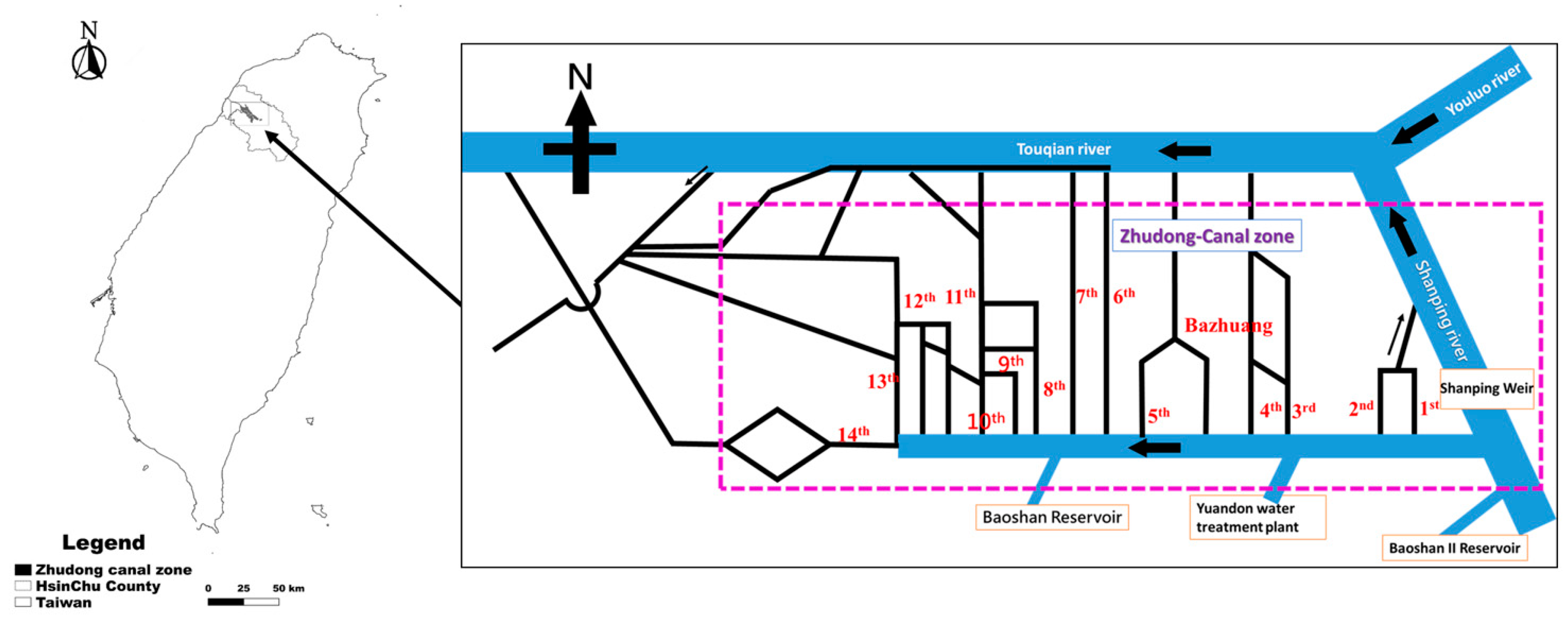
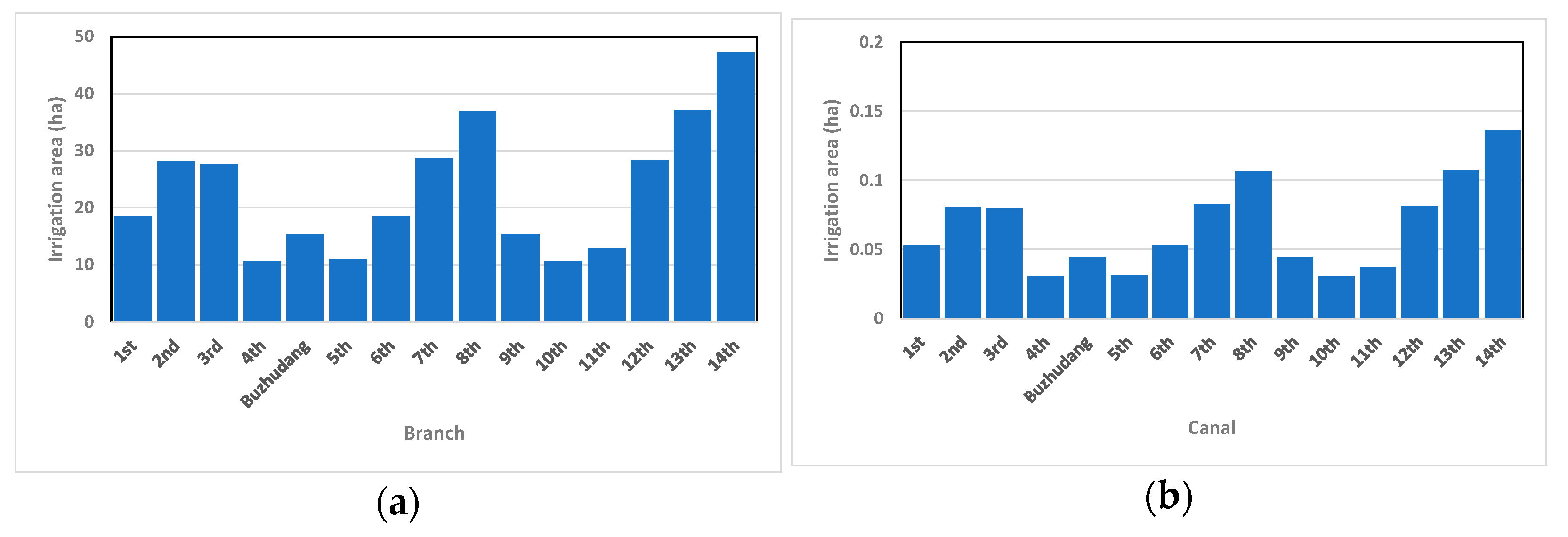


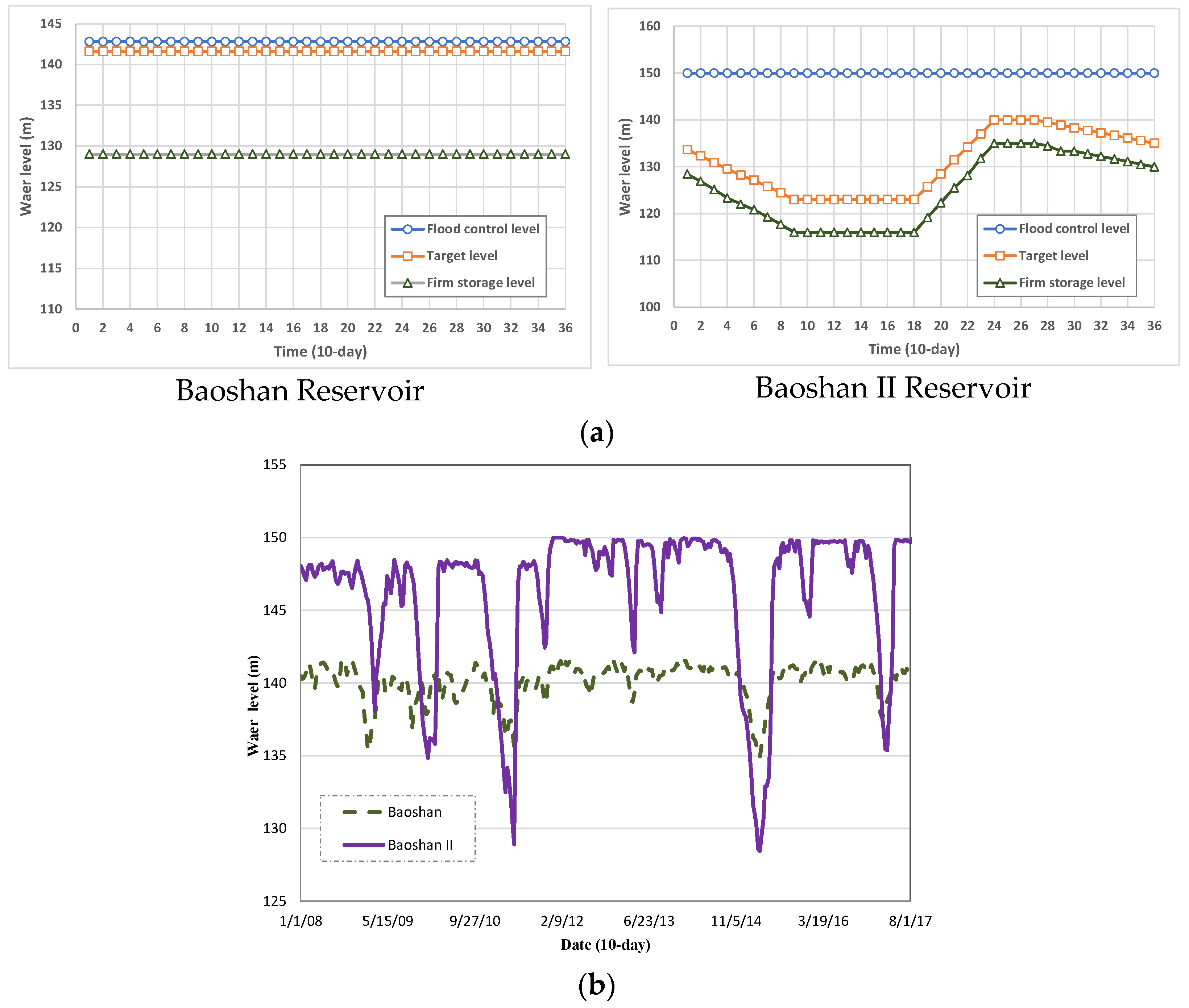
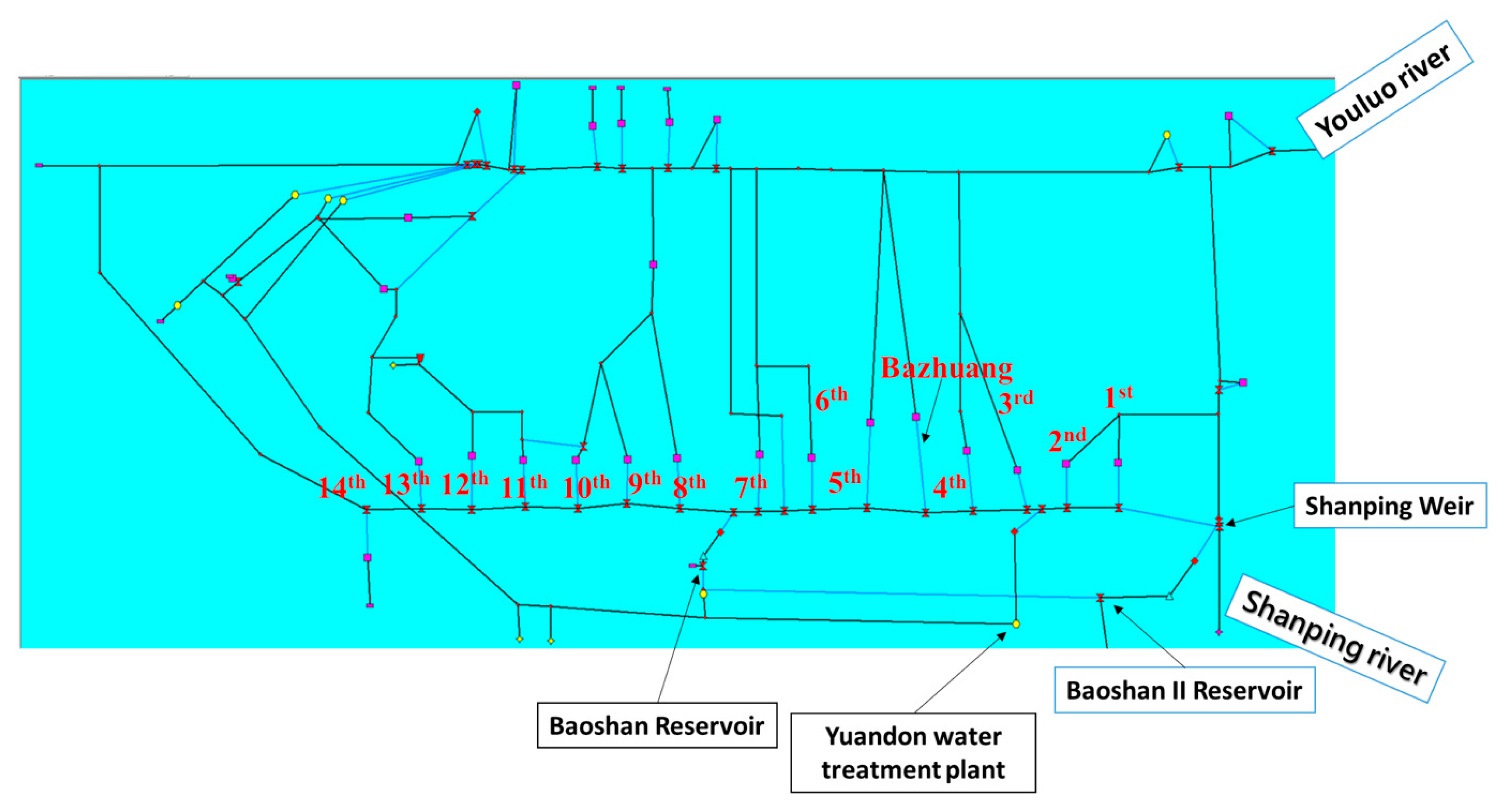

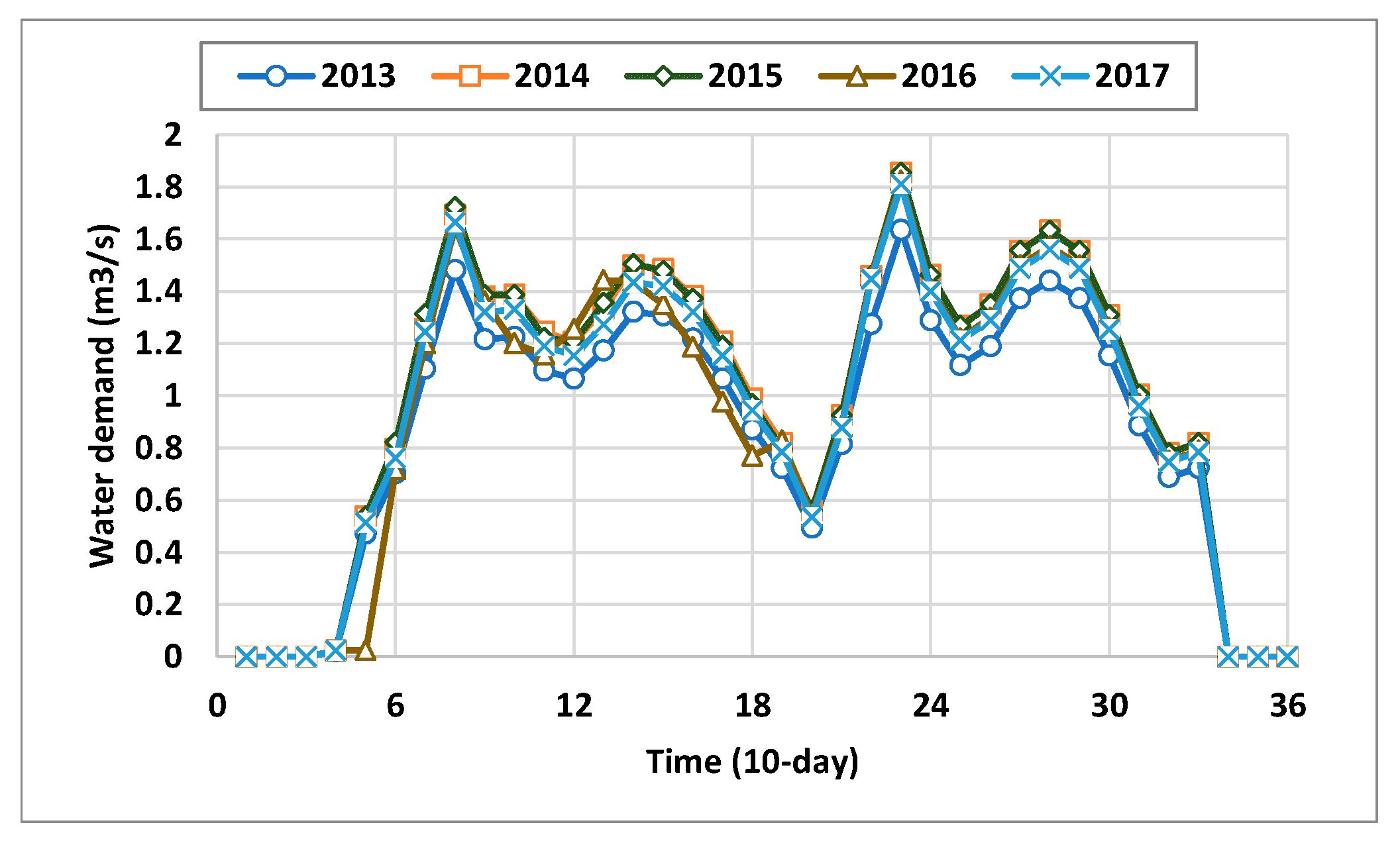


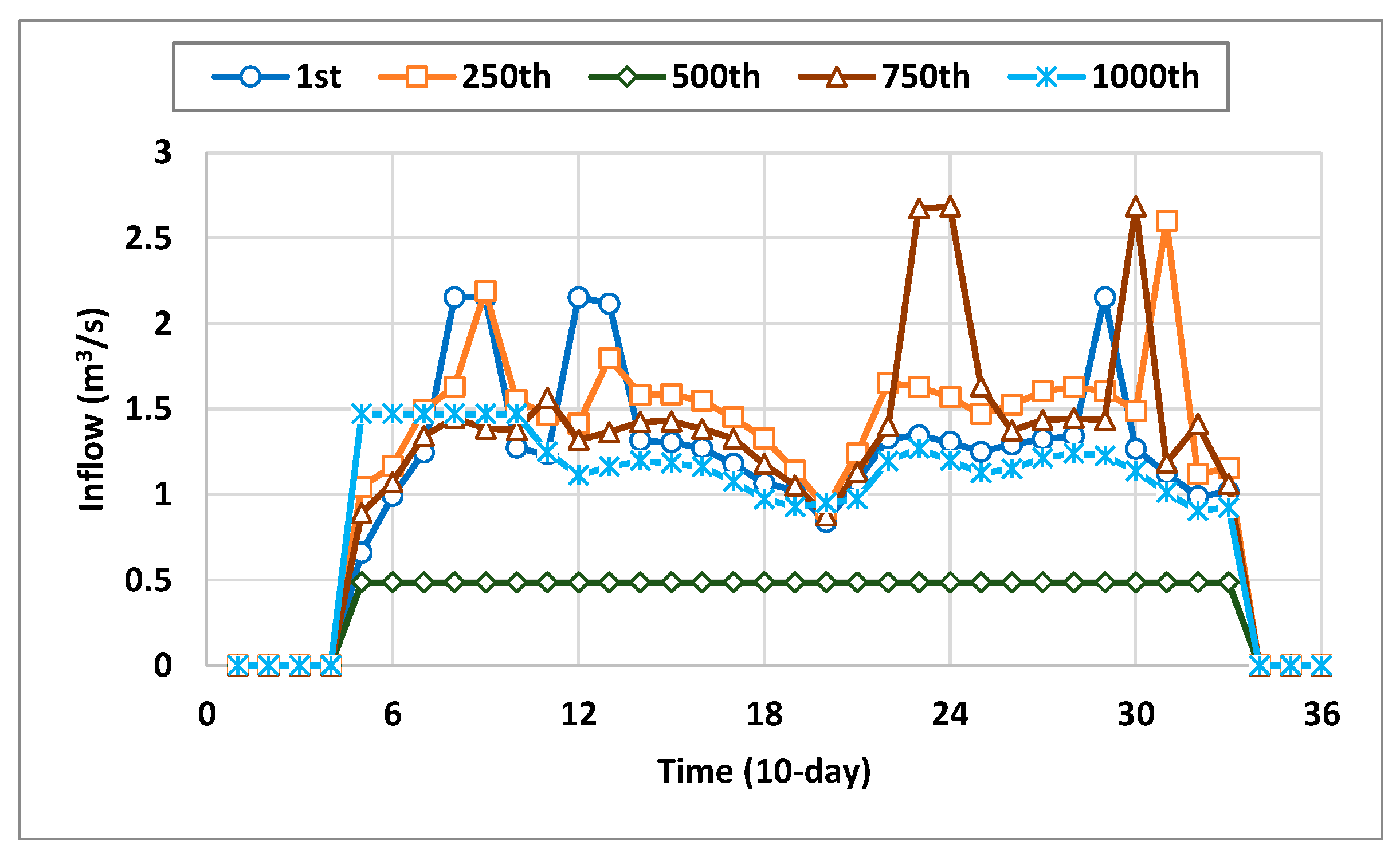
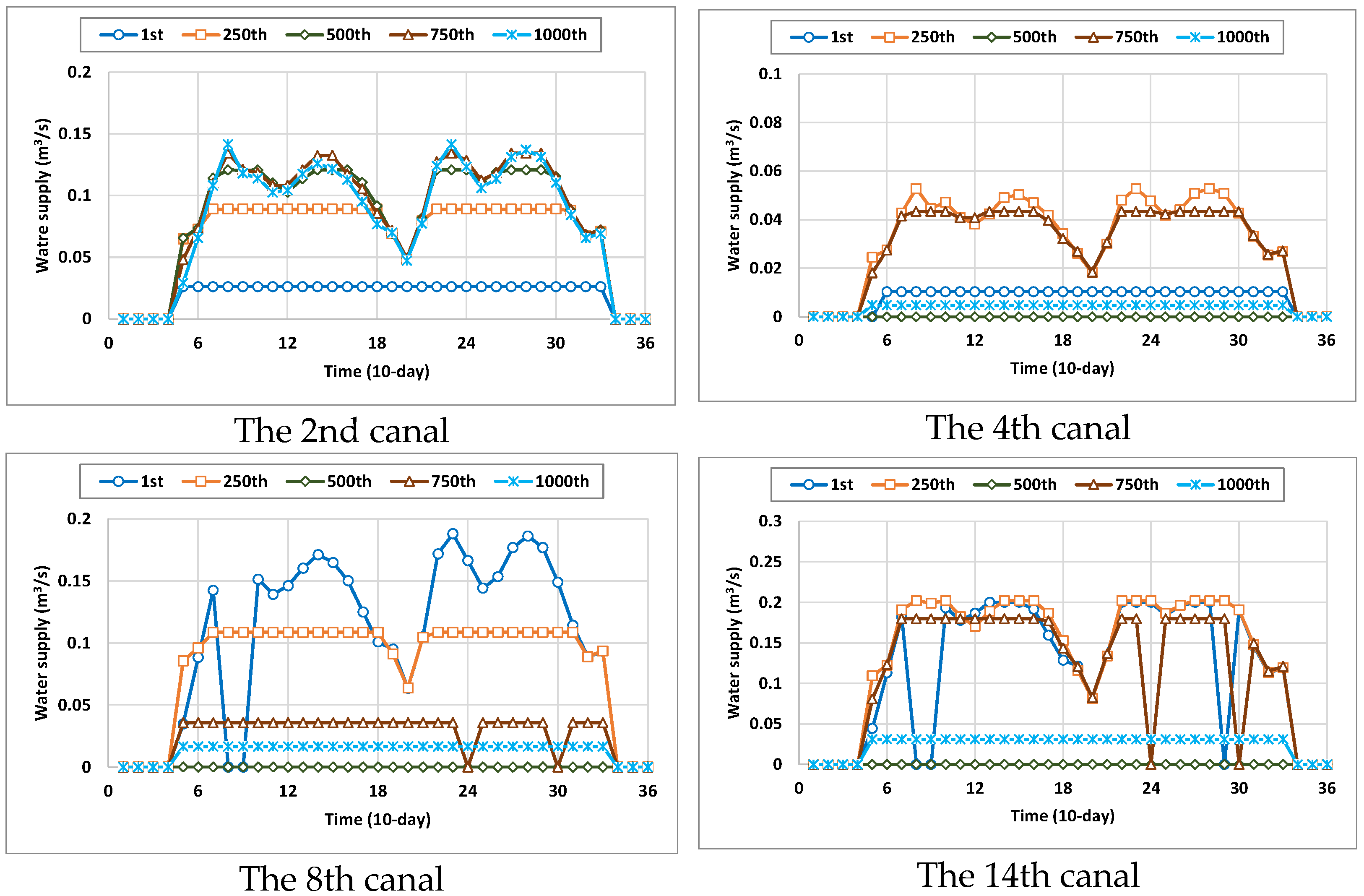

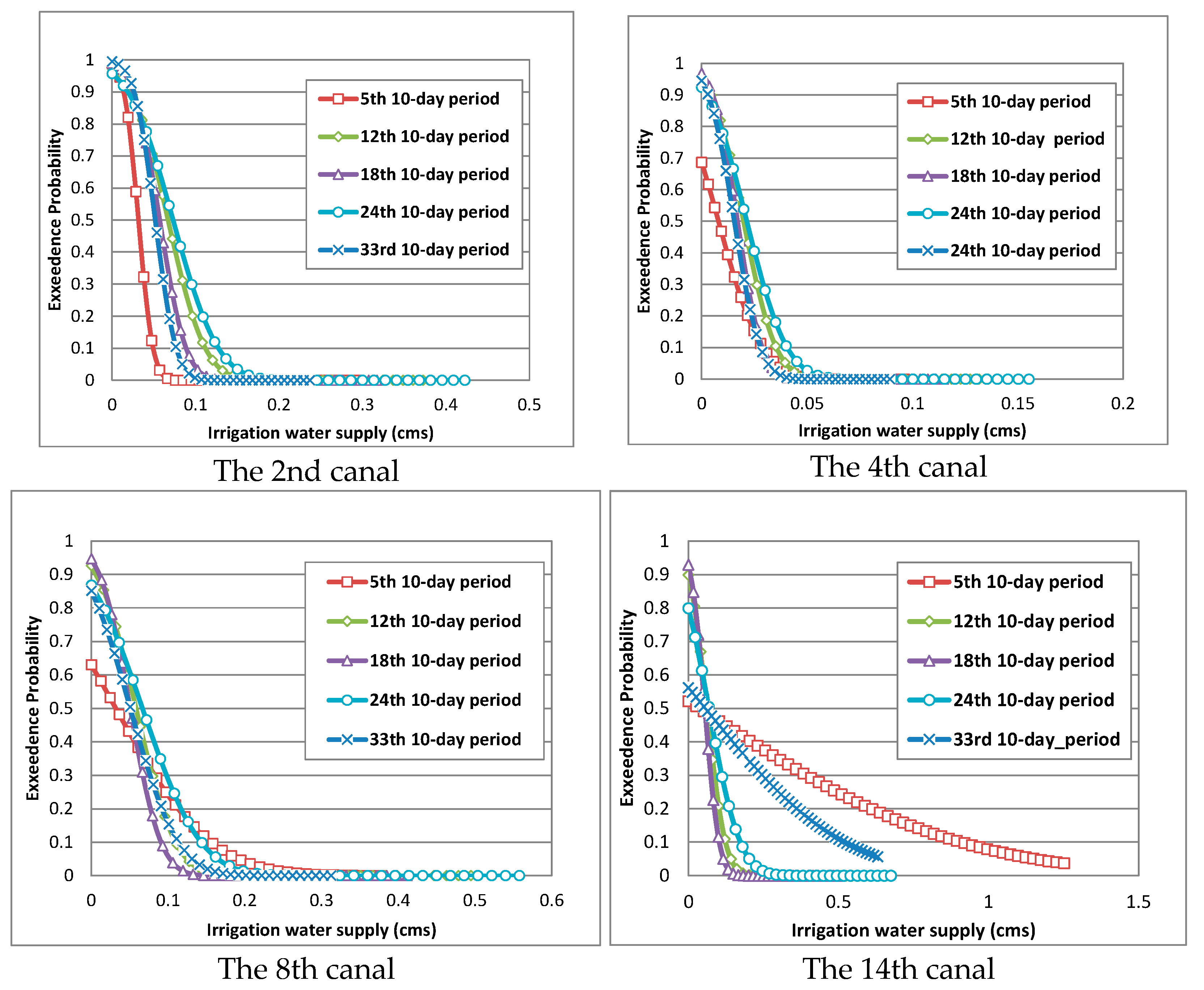

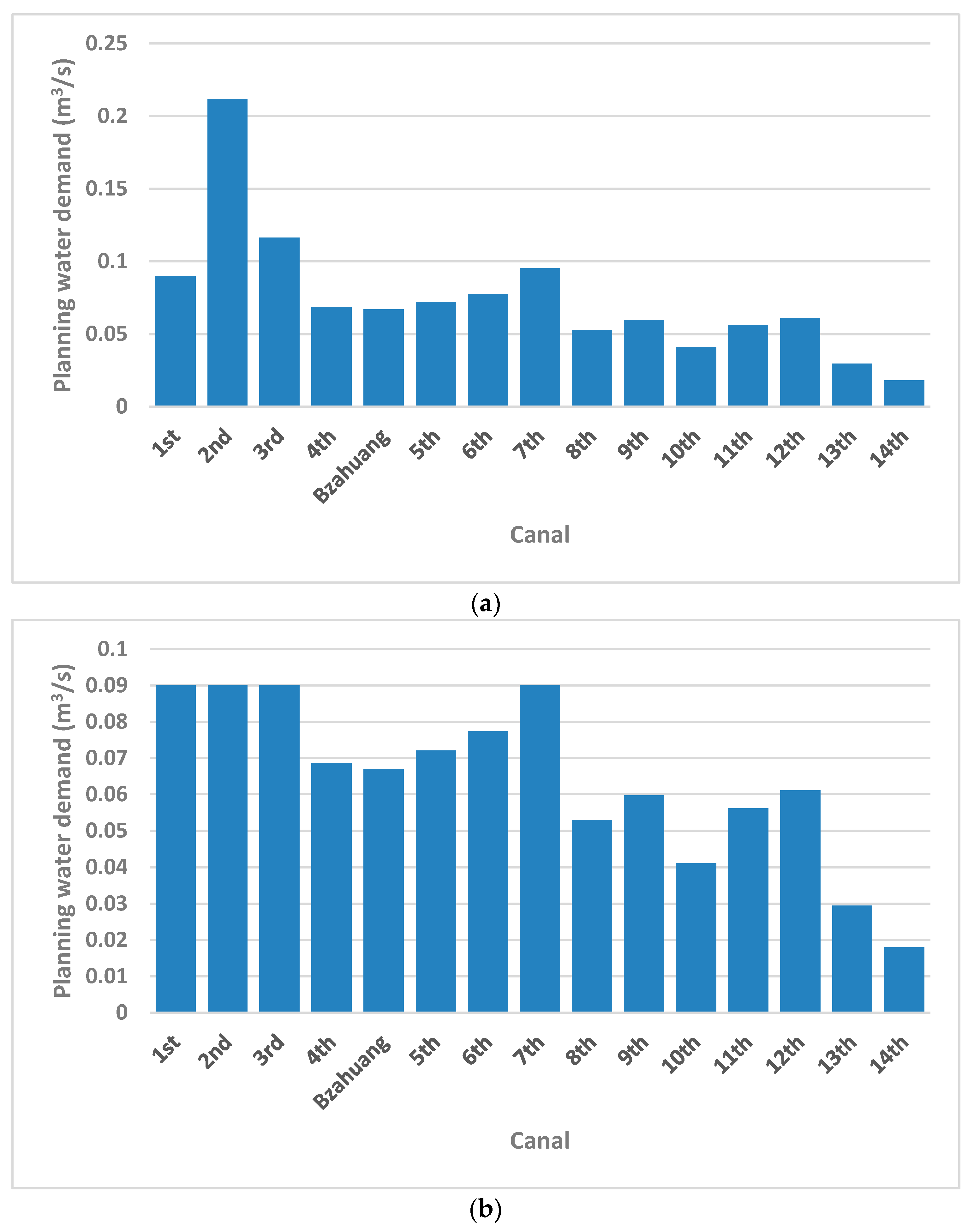
| Type of Uncertainty Factors | Uncertainty Factors | Sources/Definitions |
|---|---|---|
| Hydrological factors | Surface runoff | River |
| Underground | ||
| Hydraulic structures | ||
| Irrigation factors | Planned water demand | The minimum irrigation water volume required at the canals for the specific crop |
| Maximum water intake of the water gages | The maximum water volume through the water gates. |
| Irrigation Factor | Statistical Properties | |
|---|---|---|
| Mean | Standard Deviation | |
| Maximum water intake at the Shanping Weir (m3/s) | 1.5 | 1.0 |
| Maximum water intake of canal-based gate (m3/s) | 0.2–0.4 | 0.07–0.98 |
| Indicator of Irrigation Canal (IC) | Regression Coefficients | |||||||
|---|---|---|---|---|---|---|---|---|
| IC = 2 | −0.029 | 0.131 | 0.000074 | 0.00042 | −0.0012 | 0.0524 | −0.00036 | 0.01 |
| IC = 4 | −0.039 | 0.26686 | −0.01517 | −0.00046 | 0.016317 | 0.03947 | 0.000437 | −0.0141, −0.0076, 0.01736, |
| IC = 8 | −0.042 | −0.106 | −0.08933 | 0.00006 | 0.0959 | −0.0655 | 0.00561 | −0.096, −0.109, −0.063, 0.057, 0.04, 0.153, 0.104, 0.026 |
| IC = 14 | −0.03 | −0.138 | −0.1145 | 0.0016 | 0.12986 | −0.14173 | 0.0338 | −0.266, −0.159, −0.143, −0.254, −0.155, −0.161, −0.207, −0.147, −0.098, 0.0467, 0.045, 0.063, −0.029, 0.0466 |
| No. of Canal | Uncertainty Factor Used | ||||
|---|---|---|---|---|---|
| 2nd | √ | √ | √ | ||
| 3rd–7th | √ | √ | √ | √ | |
| 8th–14th | √ | √ | √ | √ | √ |
| No. of the 10-Day Period | Constant | Uncertainty Factor | |||||
|---|---|---|---|---|---|---|---|
| 2nd | 2.292 | 0.027 | −24.349 | −88.175 | 1.165 | 0 | 0 |
| 4th | −6.678 | 0.011 | −367.805 | 211.523 | 4.397 | 0 | 6.776 |
| 8th | −0.05 | −0.010 | −63.142 | 34.096 | 1.177 | −1.472 | 0.481 |
| 14th | −1.585 | −0.008 | −10.470 | 8.665 | 0.827 | −0.482 | 1.786 |
| Study Cases | No. of the 10-Day Period | Inflow at the Shanping Weir (m3/s) | Water Intake of the Baoshan Reservoir (m3/s) | Water Intake of the Yuandon Treatment Plant (m3/s) | Maximum Water Intake of Canal Gates (m3/s) | Irrigation Water Demand (m3/s) |
|---|---|---|---|---|---|---|
| I | 18 | 0.5–2.4 | 1.1 | 0.3 | 0.09 | 0.035 |
| II | 2.4 | 0.0–1.8 | 0.3 | 0.09 | ||
| III | 2.4 | 1.1 | 0.0–0.4 | 0.09 | ||
| VI | 2.4 | 1.1 | 0.3 | 0.05–0.1 | ||
| V | 2.4 | 1.1 | 0.3 | 0.09 | 0.1–1.0 |
Publisher’s Note: MDPI stays neutral with regard to jurisdictional claims in published maps and institutional affiliations. |
© 2022 by the authors. Licensee MDPI, Basel, Switzerland. This article is an open access article distributed under the terms and conditions of the Creative Commons Attribution (CC BY) license (https://creativecommons.org/licenses/by/4.0/).
Share and Cite
Wu, S.-J.; Mai, J.-S.; Lin, Y.-H.; Yeh, K.-C. Modeling Probabilistic-Based Reliability Analysis for Irrigation Water Supply Due to Uncertainties in Hydrological and Irrigation Factors. Sustainability 2022, 14, 12747. https://doi.org/10.3390/su141912747
Wu S-J, Mai J-S, Lin Y-H, Yeh K-C. Modeling Probabilistic-Based Reliability Analysis for Irrigation Water Supply Due to Uncertainties in Hydrological and Irrigation Factors. Sustainability. 2022; 14(19):12747. https://doi.org/10.3390/su141912747
Chicago/Turabian StyleWu, Shiang-Jen, Jie-Sen Mai, Yi-Hong Lin, and Keh-Chia Yeh. 2022. "Modeling Probabilistic-Based Reliability Analysis for Irrigation Water Supply Due to Uncertainties in Hydrological and Irrigation Factors" Sustainability 14, no. 19: 12747. https://doi.org/10.3390/su141912747




